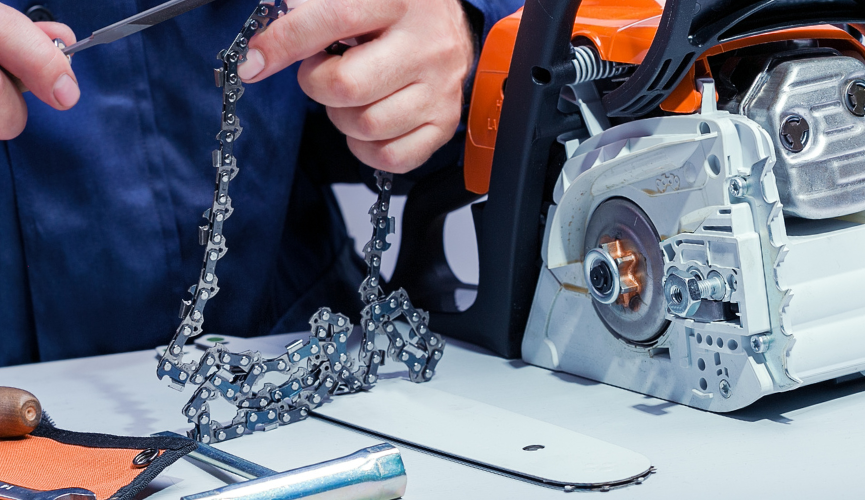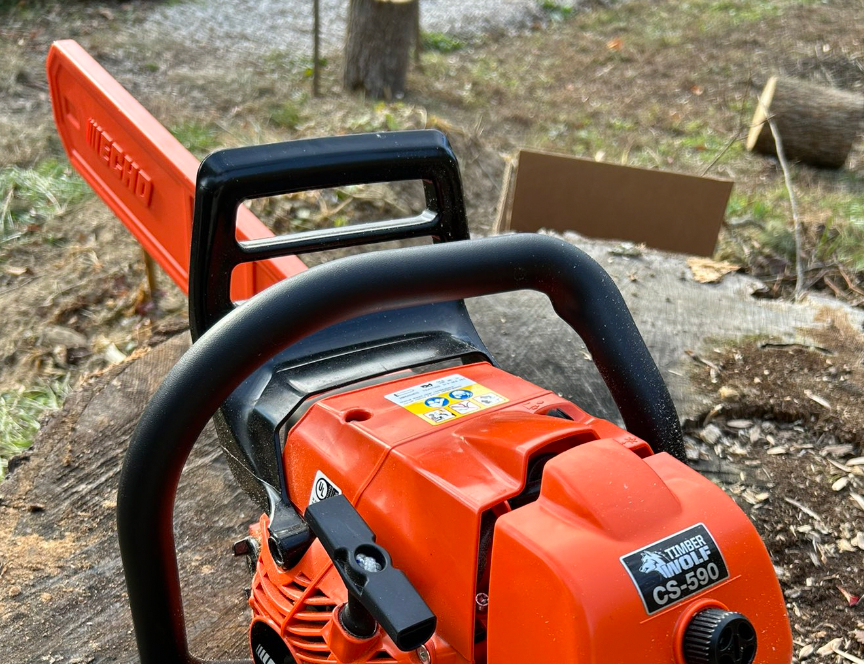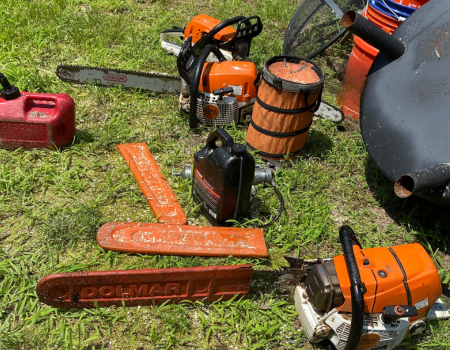How Tight Should Chainsaw Chain Be

Key Takeaways
- Proper chain tension is crucial for optimal chainsaw performance and safety.
- Most chainsaws follow the same steps, but refer to the user manual for your specific chainsaw chain tension
- The chainsaw chain should be 'fairly tight' - not overly tight, and not loose either
When it comes to using a chainsaw, one of the most important aspects to consider is the tension of the chain. A properly tensioned chain ensures optimal performance and safety while using the tool.
But how tight should the chainsaw chain be? This is a common question that many people have, and the answer varies depending on the chainsaw model.

Understanding Chain Tension
Before we start, let's talk about chainsaw chain tension. Chainsaw chain tension refers to the amount of slack in the chain when it's not running.
When the chainsaw is running, the chain tightens around the bar which allows for smooth cutting.
If the chainsaw chain tension is too loose or too tight, it can lead to poor performance, it can damage the chainsaw, and it can present a safety hazard to you - the operator.
Importance of Proper Chainsaw Chain Tension
Maintaining the correct tension on your chainsaw chain is essential for optimal performance. It can be pretty hard to get the perfect tension. A chain that is too tight or too loose will have different consequences.
Too tight
Over-tightening the chain can also cause problems. A tight chain will increase friction, causing the chainsaw to work harder and reducing its efficiency.
A chain that is too tight can cause excessive wear on the bar and chain, reducing their lifespan. It can also cause the chainsaw to work harder, reducing its efficiency and increasing the risk of overheating.
Too loose
On the other hand, a loose chain can cause the chain to come off the bar or even break, which can be dangerous. Proper chain tension ensures that the chain stays on the bar and does not derail.
This is especially important when cutting through thicker or harder materials, as a loose chain can easily become dislodged. If the chain is too loose, it can cause excessive vibration, which can damage the chainsaw or worse, it can cause the saw to jump around, making it difficult to control and increasing the risk of injury.

How To Check Chain Tension
When it comes to operating a chainsaw, it is crucial to ensure that the chain is properly tensioned. There are a few different tests you can perform to check the chainsaw chain tension:
- The snap test
- The pull test
The Snap Test
One way to check the tension of your chainsaw chain is to perform the snap test. Start by wearing protective gloves and turning off the chainsaw. Then, lift the chainsaw bar and let the chain hang freely.
Next, use your index finger and thumb to gently pull the chain away from the bar. If the chain snaps back into place when released, it is properly tensioned. If the chain does not snap back, it may be too loose and require tightening.
The Pull Test
Another way to check the tension of your chainsaw chain is to perform the pull test. Again, start by wearing protective gloves and turning off the chainsaw. Then, use a flathead screwdriver to loosen the two nuts that hold the chainsaw bar in place.
Next, use your fingers to pull the chain away from the bar. The chain should move freely, but there should be no visible gap between the tip of the inner chain and the bar groove. If there is a gap, the chain may be too loose and require tightening.

How To Adjust Chain Tension
When using a chainsaw, it is important to ensure that the chain is properly tensioned. A loose chain can result in kickback, while an overly tight chain can cause damage to the chainsaw's bar and chain.
Keep in mind, if you do all the this and the chain doesn't tighten enough, you may just need a new chain. These things wear way over time. Here's how to adjust the chain tension:
Tools Required for Adjustment
Unless you have a tool free tensioner, you'll need the same tools whether you have a gas or an electric chainsaw. The process is a bit different for mini chainsaws so for now we'll stick with standard size.
To adjust the tension of your chainsaw chain, you will need the following tools:
- Scrench (a combination tool that includes a wrench and screwdriver)
- Tensioning tool (if your chainsaw comes with one)
- Screwdriver (if your chainsaw does not come with a tensioning tool)
Step-by-Step Tensioning Process
- Turn off the chainsaw and let it cool down before attempting to adjust the chain tension. Nothing more dangerous than a hot chain.
- Just in case, you can turn on the chain brake.
- Locate the adjustment screw on the chainsaw. This is typically located on the side of the chainsaw near the bar and chain.
- Use the scrench or screwdriver to loosen the nuts that hold the chainsaw's bar in place.
- Use the tensioning tool or screwdriver to turn the adjustment screw clockwise to tighten the chain or counterclockwise to loosen the chain.
- Check the tension of the chain by pulling it away from the bar. The chain should be snug against the bar but still able to move freely.
- Once the chain is properly tensioned, use the scrench or screwdriver to tighten the nuts that hold the bar in place.
- Check the tension of the chain again to ensure it is properly tensioned.
By following these simple steps, you can ensure that your chainsaw chain is properly tensioned and ready for use. Remember to check the tension of the chain regularly, as it can loosen over time with use.
Maintaining Chain Tension
To ensure the best performance and safety while using a chainsaw, it is important to maintain the optimal tension of the chain. Proper chain tension reduces the risk of kickback and extends the life of the chain and other chainsaw parts.
Regular Maintenance Tips
Regular maintenance is key to keeping your chainsaw chain tension at the right level. Here are some tips to help you maintain optimal chain tension:
- Check the tension of the chain before each use. A loose chain can jump off the guide bar and cause serious injury.
- Adjust the tension of the chain when it becomes loose. A tight chain can cause the engine to overheat and damage the chain and guide bar.
- Keep the chain clean and free of debris. Dirt and debris can cause the chain to become loose or damage the guide bar.
- Check the manufacturer's guide for recommended chain tension. This can vary depending on the make and model of the chainsaw.
Troubleshooting Common Issues
If you're experiencing issues with your chainsaw chain slipping from the bar, chain tension not holding, or excessive chain wear, there are a few things you can do to troubleshoot the problem.
Chain Slipping from the Bar
If your chainsaw chain is slipping from the bar, it is likely due to a loose chain. You can tighten the chain by using the tensioning pin on the chainsaw. Make sure to tighten the chain until it is snug against the bar, but not so tight that it can't move freely.
If the chain continues to slip, it may be due to a worn sprocket or clutch. These parts can wear out over time and cause the chain to slip. It's best to have a professional take a look at your chainsaw if you suspect this is the issue.
Chain Tension Doesn't Hold
If your chain tension doesn't hold, it may be due to worn drive links on the chain. These links can break over time, causing the chain to loosen. You can replace the chain or have a professional replace the drive links to fix the issue.
Another common cause of chain tension not holding is a loose guide bar nose. Make sure the bar nuts are tightened properly and that the bar is securely attached to the chainsaw. Make sure the chain is tight around the drive sprocket.
Excessive Chain Wear
Excessive chain wear can cause the chain to break or snap, which can be dangerous. To prevent this, make sure to keep the chain lubricated with bar oil and check the tension regularly.
If you notice excessive wear on your chain, it may be time to replace it. Make sure to use the correct size and type of chain for your chainsaw to ensure proper operation.
By following these troubleshooting steps, you can ensure that your chainsaw chain is properly tensioned and maintained for safe and efficient use.
Sometimes no matter what you do the chain just don't stay on the bar. If that's the case, you might just need to
replace the chain. Chainsaw chains wear out after long or improper use.
Specific Chainsaw Models
When it comes to adjusting the tension of your chainsaw chain, it's important to know the specific requirements of your chainsaw model. Doesn't matter if the chainsaw is gas or electric.
Here are some tips for adjusting the chain tension on the best chainsaw models:
- Husqvarna
- Oregon
- Stihl
- Echo
- Dewalt
Chainsaw chains for each brand will have a different instruction manual for chainsaw chain tension and how to tighten the chain.
RELATED: Oregon CS1500 Chainsaw Review
Be sure to refer to the individual owners manual for your chainsaw chains proper chainsaw chain tension. If it doesn't seem like you can fix your chainsaw, check out a local dealer (i.e, a local stihl dealer).
Final Say On How Tight A Chainsaw Chain Should Be On Your Chainsaw
Knowing how tight the chainsaw chain should be on your chainsaw is critical for performance and increasing the longevity of the chainsaw.
We outlined above the major mistakes and issues that can happen if you have the wrong chain tension.
Adjust accordingly and keep your chainsaw around for years to come.
FAQs

Carl Anderson
Carl Anderson is an avid outdoorsman with a keen interest in writing about and reviewing tools. He has over 20 years of writing experience and the only time he isn't feverishly typing away at his computer is when he's outside in nature working on his projects. You can learn more about him here.
Join our community!
Join to receive guides, insights, and the latest gardening deals!
